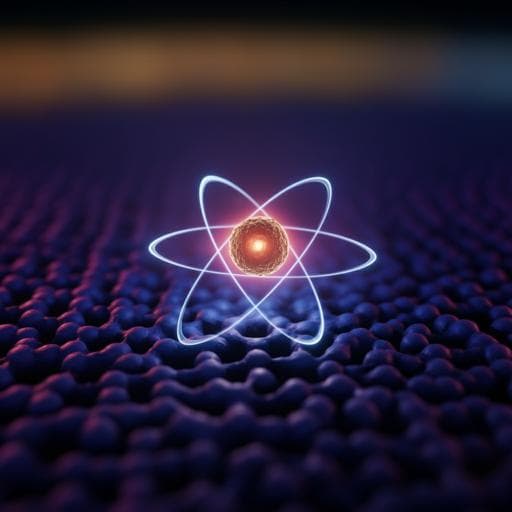
Physics
Complete reversal of the atomic unquenched orbital moment by a single electron
R. Rejali, D. Coffey, et al.
This groundbreaking research reveals how a single iron atom can have its spin and orbital moments independently controlled. By positioning the atom on a nitrogen site within a Cu₂N lattice, the team presents a novel approach to manipulating atomic properties through electron tunneling. This fascinating work was conducted by Rasa Rejali, David Coffey, Jeremie Gobeil, Jhon W. González, Fernando Delgado, and Alexander F. Otte.
~3 min • Beginner • English
Introduction
The study targets independent control of spin (S) and orbital (L) angular momenta in single magnetic atoms adsorbed on surfaces. Typically, orbital moments are quenched by the crystal field and spin-orbit coupling mixes S and L, limiting control to the spin degree of freedom and reducing magnetic anisotropy energy (MAE). Large and stable MAE is crucial for single-atom information storage. The authors engineer a local axial crystal field by placing a single Fe atom atop the fourfold symmetric nitrogen site of a Cu₂N/Cu₃Au(100) surface, aiming to preserve an unquenched orbital moment and achieve large zero-field splitting, thereby enabling independent excitations of spin and orbital moments. They seek to demonstrate full orbital-moment reversal via a single-electron tunneling event without altering the spin, and to corroborate this with first-principles theory.
Literature Review
Prior single-atom magnetism work has focused on spin manipulation using STM/IETS due to prevalent orbital quenching on surfaces. Engineering axial crystal fields can preserve orbital moments and enhance MAE. Notably, Fe and Co atoms on MgO/Ag(100) exhibit near-axial symmetry and large zero-field splittings (Fe ~14 meV, Co ~58 meV), yet their energy multiplets are mixed in S and L so independent L- and S-excitations are not realized. Orbital excitations have been observed previously, but complete, independent rotation of an unquenched orbital moment has not been shown. This work builds on these studies by realizing nearly pure product states of S and L and demonstrating independent excitations, including a full ΔLz = 4 transition with ΔSz = 0.
Methodology
- System and preparation: Single Fe atoms were deposited onto monolayer insulating Cu₂N islands grown on a Cu₃Au(100) surface via nitrogen sputtering, in an ultrahigh-vacuum low-temperature STM (Unisoku USM1300s). The STM operated at 330 mK with variable out-of-plane magnetic field up to 5 T. IETS was performed with lock-in detection, using tips functionalized by picking up Fe atoms from the surface to enable spin sensitivity.
- Experimental measurements: Differential conductance (dI/dV) spectra were obtained on individual Fe atoms and bare Cu₂N, at setpoints such as 90 mV, 8 nA with modulation amplitudes (e.g., 400 μV or 150 μV). Field-dependent IETS mapped spin and orbital excitation thresholds versus B.
- Modeling and theory: Two complementary modeling approaches were used:
1) An anisotropic spin-orbit Hamiltonian acting on orbital eigenstates with Stevens operators and Zeeman coupling: H = B_o^2 O_2^0 + B_o^4 O_4^0 + B_o^4 O_4^4 + A_so L·S + μB g (L + 2S)·B. Parameters were fitted to reproduce spectra, yielding nearly uniaxial easy-axis behavior and spin-orbit coupling A_so ≈ -9.41 meV. This model treats S and L explicitly, obviating an effective spin-only Hamiltonian.
2) First-principles-informed point-charge model (PCM) and electronic multiplet calculations based on a Wannier Hamiltonian to incorporate crystal and ligand fields, charge transfer, and surface polarization. Multiplet calculations used Hubbard U = 5.208 eV (U−J = 5 eV), atomic radial integrals ⟨r⟩ = 1.393 and ⟨r^4⟩ = 4.496 a.u., and a screened spin-orbit coupling (screening factor 0.738) leading to an effective SOC of -9.60 meV to match the ~18 meV spin excitation. Transport in the cotunneling regime assumed electron–hole symmetry, with hybridizations Vs = 0.562 eV and Vt = 0.183 eV. Couplings used were (ρJks) = 0.25 for surface, (ρJkt) = 0.0484 for tip, and a direct tunneling term (ργ) = 0.25.
- Transport and cotunneling analysis: Inelastic spin (ΔS ≤ 1) and orbital transitions were analyzed within a cotunneling framework, computing transition amplitudes between product states |Sz⟩|Lz⟩. A dominant orbital transition path from ground state |0⟩ = |-2⟩|-2⟩ to |8⟩ = |-2⟩|+2⟩ proceeds via a negatively charged virtual state with Sz = −3/2, Lz = 0, corresponding to an electron tunneling onto lz=+2 and off lz=−2, effecting ΔSz = 0, ΔLz = 4.
- Nonequilibrium dynamics: Co-tunneling transition rates and state occupations were calculated in the weak-coupling limit using a Pauli master equation to simulate occupation changes across inelastic thresholds and account for dynamical effects in dI/dV lineshapes. Conductance dependence was explored experimentally and compared to model predictions, including tip-induced exchange fields that shift thresholds.
Key Findings
- The Fe-on-N site of Cu₂N/Cu₃Au(100) realizes a single-atom system with large magnetic anisotropy and an unquenched uniaxial orbital moment close to the free-atom value, yielding a large zero-field splitting ~18 meV (largest reported for Fe atoms on surfaces).
- Independent excitations of spin and orbital moments are observed:
• Spin-only transitions (ΔSz = ±1, ΔLz = 0) between |0⟩ = |-2⟩|-2⟩ and |2⟩ = |-1⟩|-2⟩, and between |1⟩ = |+2⟩|+2⟩ and |3⟩ = |+1⟩|+2⟩. At zero field, V02 ≈ V13 = 18.4 ± 0.6 meV; at B⊥ = 4 T, split thresholds at 17.9 ± 0.7 meV and 19.4 ± 0.7 meV.
• A higher-energy orbital excitation at 73.9 ± 0.8 meV (V08), corresponding to |0⟩ → |8⟩ = |-2⟩|+2⟩, which is a full rotation of the orbital moment (ΔLz = 4) with no spin change (ΔSz = 0).
- Field dependence (up to 5 T): thresholds shift linearly due to Zeeman effect with slopes 0.23 ± 0.04 meV/T for the spin transition (V02) and 0.31 ± 0.05 meV/T for the orbital transition (V03). The experimental slope ratio is 1.3 ± 0.3, consistent with model predictions (1.6–2). The orbital step broadens with field, compatible with splitting into |0⟩→|8⟩ and |1⟩→|9⟩ components.
- Transport calculations from the PCM (with SOC screening) and multiplet theory reproduce the spectra and field evolution with high fidelity, though the calculated orbital threshold required a horizontal shift of ~−1.4 meV to align with experiment.
- Nonequilibrium effects near the spin excitation threshold produce non-square dI/dV steps and occupation redistribution, indicating relaxation times from the first excited spin state exceeding the average inter-electron time (~200 ps at 1 nA). Conductance-dependent measurements show reduced nonlinearity and tip-exchange-field-induced threshold shifts at higher currents.
- A cotunneling pathway via a charged virtual state explains the ΔLz = 4 transition while conserving total angular momentum when including the tunneling electron’s orbital moment and the lattice (Einstein–de Haas considerations).
Discussion
The results directly address the challenge of orbital quenching that has limited single-atom magnetism to spin-only control. By engineering a fourfold symmetric nitrogen binding site on Cu₂N, the Fe atom retains an unquenched uniaxial orbital moment and exhibits large MAE and zero-field splitting. The emergent multiplets are nearly pure product states of S and L, enabling independent manipulation and spectroscopy of spin and orbital degrees of freedom. The observation of a ΔLz = 4 transition with ΔSz = 0 demonstrates complete reversal of the orbital moment by a single electron without affecting the spin, while separate spin-only excitations confirm decoupled control routes. The cotunneling mechanism via a charged virtual state accounts for the orbital rotation and reconciles angular momentum conservation through the tunneling electron’s orbital contribution and lattice coupling. Agreement between experimental data and first-principles-informed models (PCM, multiplet/Wannier) substantiates the microscopic picture, including the Zeeman evolution of thresholds. These findings expand the operational degrees of freedom for atomic-scale information processing, suggesting that both spin and orbital moments can be harnessed as independent bits or coupled resources, with enhanced stability provided by the large anisotropy tied to the preserved orbital moment.
Conclusion
The study demonstrates a single-atom platform (Fe on the N site of Cu₂N/Cu₃Au(100)) with a large magnetic anisotropy and an unquenched uniaxial orbital moment close to the free-atom limit. Using STM-based IETS with a functionalized tip, the authors realize independent control of spin and orbital degrees of freedom, including a full inversion of the orbital moment (ΔLz = 4) by a single electron without changing the spin, alongside distinct spin-only excitations. First-principles-informed models and multiplet calculations corroborate the observations and elucidate the cotunneling pathways. This adds a new dimension to single-atom magnetism and provides a basis for designing extended lattices in which interactions via both spin and orbital moments can be explored. Future work could exploit orbital control in coupled atomic arrays, investigate coherence and relaxation pathways of orbital excitations, and engineer environments to optimize selectivity and robustness of spin-orbital operations.
Limitations
- A consistent ~1.4 meV discrepancy exists between calculated and measured orbital excitation thresholds, requiring a shift to align transport simulations with experiment, likely reflecting sensitivity to tip-induced fields, local environment, and model approximations.
- The spin-orbit coupling strength was effectively treated as a fitted, screened parameter to match the ~18 meV spin excitation; electron–hole symmetry and specific hybridization values were assumed in transport modeling.
- Spectral features show nonequilibrium dynamics and unusual lineshapes near thresholds, complicating precise determination of step energies and requiring error margins; relaxation times from the excited spin state exceed inter-electron arrival times at typical currents.
- Observations rely on tip functionalization and spin-polarized junction conditions, which can vary between measurements and atoms, leading to slight offsets in thresholds and lineshapes.
Related Publications
Explore these studies to deepen your understanding of the subject.







